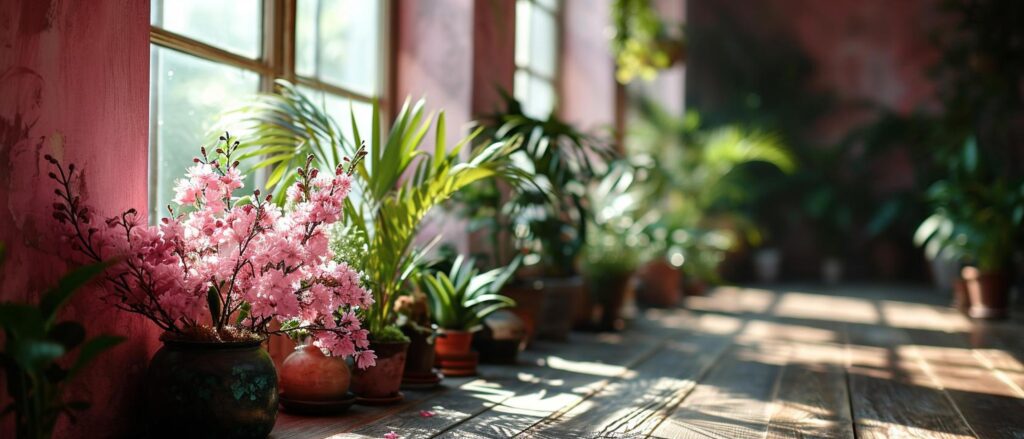Not every indoor space enjoys abundant natural light, but that doesn’t mean you can’t create a thriving indoor garden. Many plants have evolved to flourish in shaded conditions, making them perfect candidates for darker corners, north-facing windows, or rooms with limited natural light. Understanding these shade-tolerant varieties opens up endless possibilities for bringing greenery into any space.
Understanding Low-Light Environments
Low-light conditions don’t mean no light at all. These environments typically receive indirect light filtered through other buildings or trees, or ambient light from north-facing windows. Different areas of your home may offer varying levels of low light, creating multiple opportunities for plant placement. Understanding these light patterns helps you choose and position plants for optimal growth.
ZZ Plant (Zamioculcas zamiifolia)
The ZZ plant stands as a champion among low-light plants, thriving in conditions that would challenge most other varieties. Its glossy, dark green leaves add a sophisticated touch to any space while requiring minimal care. This hardy plant tolerates long periods between watering and maintains its attractive appearance even in quite dark conditions. Its upright growth habit works well in corners or as a tabletop specimen.
Chinese Evergreen (Aglaonema)
Chinese evergreens bring color and pattern to low-light areas through their beautifully variegated leaves. These adaptable plants come in varieties featuring different combinations of green, silver, and pink, allowing you to add visual interest to darker spaces. Their moderate growth rate and tolerance for various conditions make them excellent choices for beginners exploring low-light gardening.

Cast Iron Plant (Aspidistra elatior)
The cast iron plant lives up to its name through incredible durability and tolerance for low-light conditions. Its broad, upright leaves remain deep green even in significant shade. This plant grows slowly but steadily, requiring minimal maintenance while providing reliable greenery. Its architectural form makes it perfect for adding structure to room corners or creating natural screens.
Pothos (Epipremnum aureum)
Pothos varieties offer versatile options for low-light spaces, with trailing vines that can brighten dark corners or climb surfaces. Their heart-shaped leaves come in patterns and colors, from classic golden pothos to marble queen varieties. These adaptable plants grow well in hanging baskets or trained-up supports, allowing you to create vertical interest in areas with limited light.
Snake Plant (Sansevieria)
Snake plants thrive in low light, adding strong vertical elements to your space. Their striking leaves grow upright, requiring minimal floor space while making bold architectural statements. Different varieties offer varying patterns and heights, from dwarf forms perfect for desks to tall specimens ideal for floor displays. Their exceptional tolerance for low light and infrequent watering makes them perfect for neglected corners.
Peace Lily (Spathiphyllum)
Peace lilies bring elegant white blooms to low-light areas while maintaining attractive foliage year-round. These forgiving plants communicate their needs clearly, drooping slightly when they need water and perking up quickly after receiving it. Their glossy leaves maintain good color even in the shade, and occasional flowers provide welcome brightness in darker spaces.
Bird’s Nest Fern (Asplenium nidus)
Bird’s nest ferns add tropical texture to low-light areas through their wavy, bright green fronds. Unlike many ferns, they tolerate lower light conditions while maintaining their distinctive appearance. Their compact growth habit makes them perfect for shelves or tabletops, where their unique foliage can serve as natural artwork.
Philodendron Varieties
Philodendrons offer numerous options for low-light situations, from trailing varieties perfect for hanging baskets to upright types suitable for floor displays. Their heart-shaped leaves maintain good color in shade, and their adaptable nature makes them reliable choices for various indoor conditions. Different varieties provide options for leaf size and growth habit, allowing you to choose perfect specimens for your space.
Creating Depth with Layering
Arrange low-light plants at varying heights to create visual interest in darker areas. Place taller specimens like snake plants or cast iron plants against walls, with medium-height plants like peace lilies in the middle ground. Add trailing pothos or philodendrons at the front or in elevated positions to create natural layers that draw the eye through the space.
Maximizing Available Light
Even shade-tolerant plants benefit from thoughtful positioning to maximize available light. Clean windows regularly to ensure maximum light transmission. Consider using light-colored walls or mirrors to reflect and amplify available light. Rotate plants periodically to ensure even growth, as low-light plants grow toward light sources.
Seasonal Adjustments
Adapt your care routine to seasonal changes in light levels. Most low-light plants need less water during winter months when growth naturally slows. Monitor humidity levels, mainly when heating systems run, as many shade-tolerant plants appreciate higher humidity. Adjust feeding schedules seasonally, reducing or eliminating fertilizer during winter months.
Maintenance Strategies
Establish simple maintenance routines to keep your low-light plants healthy. Remove dust from leaves regularly to maximize their light-gathering ability. Inspect plants periodically for signs of stress or pest problems, addressing issues promptly. Trim away any yellow or dead leaves to maintain attractive appearances and encourage healthy growth.
Low-light plants can create beautiful living displays in even the darkest corners of your home. These adaptable plants will thrive through careful selection and positioning while transforming challenging spaces into green sanctuaries. Remember that even if minimal, consistent care helps ensure your shade-tolerant plants remain healthy and attractive throughout the year.




